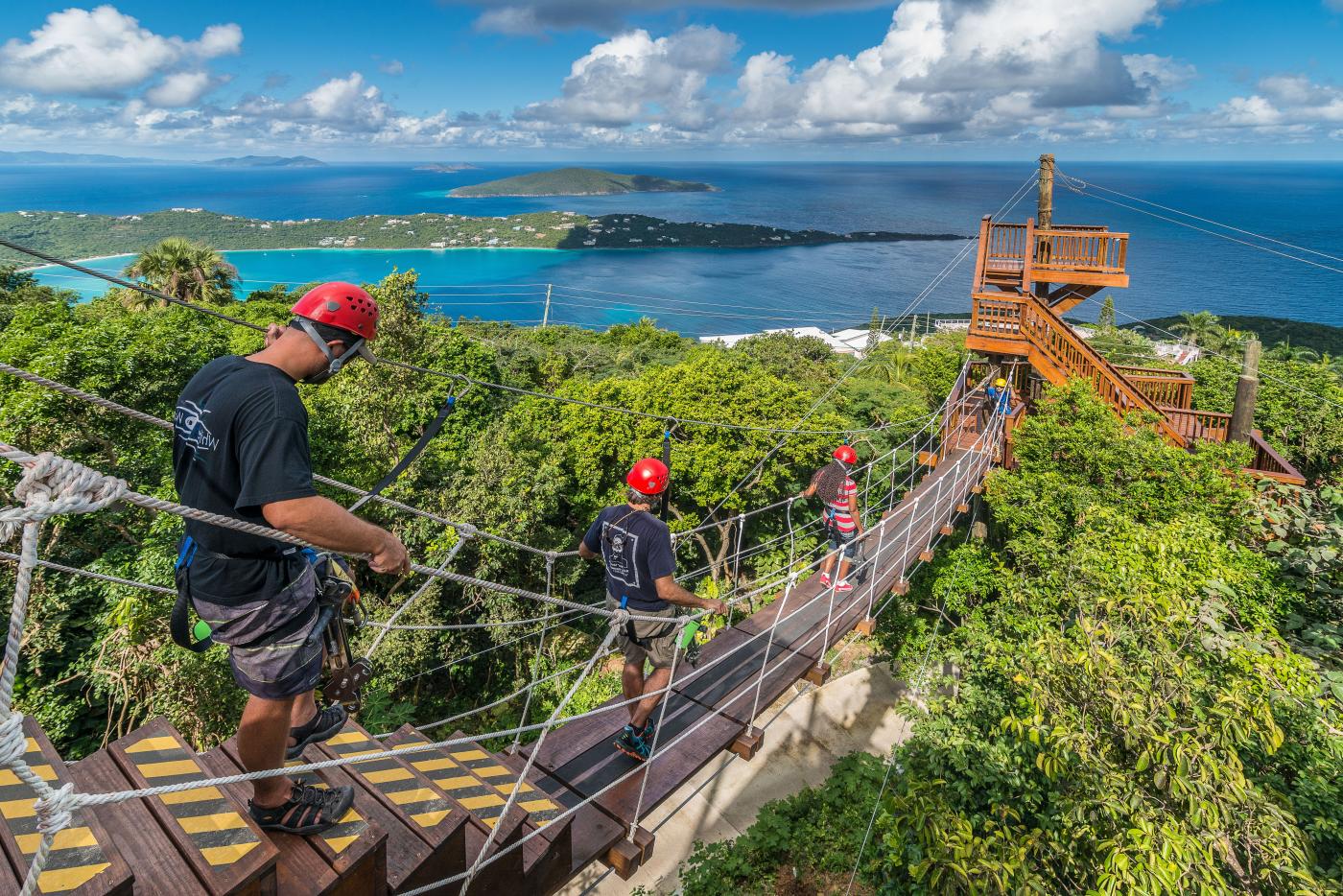







General Information
Though it’s only 32 square miles in size, St. Thomas has a million miles worth of things to do.
Go shopping and sailing, snorkeling and sightseeing, or diving and dining. Enjoy the island’s
world-renowned golf course, picture-perfect beaches and spectacular nightlife. Take the Skyride 700 feet above
the city or climb the famous 99 Steps of Charlotte Amalie for an incomparable view of the Caribbean.
And if you’re interested in culture and history, don’t miss seeing the second-oldest synagogue in
the Western Hemisphere, the 1680-built Fort Christian or the childhood home of
Camille Pissarro, one of the best-known French Impressionists.
Culture/History
The first documented residents of the present-day US Virgin Islands, the Ciboney, arrived on the
islands during the Pre-Ceramic Culture. The Arawaks settled on St Croix and St John in approximately
100 AD, followed by the peaceful Taino and fierce Carib. The most obvious remnants of these early
cultures are the ancient Taino petroglyphs carved into the rocks at the Reef Bay Trail, part of the
Virgin Islands National Park (1300 Cruz Bay Creek, St John). Christopher Columbus named and claimed
the Virgin Islands for Spain during his second New World voyage in 1493, but no fewer than five other
countries also ruled over the islands at various points during the following two centuries. Denmark,
however, was the country which established the islands’ first permanent settlement in 1672 and held
onto the islands longer than any other countries. In 1733, France sold the island of St Croix to the
Danish West India Company, which already controlled both St Thomas and St John. Sugar cane plantations
filled with slaves became the backbone of the islands’ economy throughout the 18th and early 19th centuries.
Many of the landmark buildings belonging to the Christiansted National Historic Site (2100 Church Street,
Christiansted) in St Croix’s capital date from this boom period, which ended with the 1848 abolition of
slavery on the islands. Denmark lost interest in the Virgin Islands once sugar production came to a halt.
The first treaty to sell the islands to the United States was drawn in 1867, but the Danish government did not
formally hand the islands over to the United States until 1917. The United States feared Germany would attack
the islands and establish a submarine base there during WWI. The islands’ residents became official United States
citizens in 1927, a status they have enjoyed ever since. The US Virgin Islands first became popular tourism
destinations after the 1959 embargo on American travel to Cuba. Not even a steady stream of hurricanes between
the late 1980s and late 1990s have stopped the equally steady stream of tourists to the US Virgin Islands.
Food
For great local West Indian food visit St. Thomas top local restaurants: Gladys Cafe in Royal Dane Mall, Cuzzins on Back Street and also on Back Street.
Pate: Pates are made from a flaky white flour dough that encloses a hot pepper-spiked mixture of ground beef, conch, salted codfish or vegetables. The dough
is wrapped around the filling turnover fashion, and then deep fat fried and you must-try-local-foodsCaribbean lobster: Unlike its North American cousin, this
shellfish has no claws. Most of the meat is in the tail. Lobster tail is served split and grilled with melted garlic butter or the meat is mixed into rice or soup.
Conch in Butter Sauce: Meat from this marine mollusk can be tough. But, sliced thin and pressure cooked, its melt-in-your-mouth tender and a real treat when served
swimming in a rich butter sauce chock-full of sliced onions. Kallaloo: Spinach, okra and local native greens are the base for this thick soupy stew. Conch, crab, fish,
salt beef or smoked pig tail added for extra gusto. Custo marily this dish is served with a heaping helping of fungi. Goat Water: Goat meat is this thick brown stews
main ingredient. Its a rib-sticking robust-tasting dish that is often enjoyed as a breakfast food. Dumb Bread: This rich round loaf is dubbed for the very clever way
in which its made. The white flour dough, often sweetened with shredded coconut, is placed into a skillet and set over hot coals. More hot coals are placed over the
skillet’s lid to cook the bread from above and below until its toasty brown. Dumb bread is usually cut in pie-shaped wedges, split in the middle and filled with cheddar cheese.
Whelks & Rice: A real delicacy, these large marine snails are sizzled in garlic butter and folded into fluffy white rice. Johnny Cakes: These hand-sized rounds of fried bread
are sold by themselves as a snack or with a fried chicken leg for a light lunch. Roti: The real definition of roti is a tortilla-type flat bread. However, most folks
offering roti sell it as a complete sandwich where the thin bread is wrapped around a curried meat, seafood or vegetable filling. Bullfoot Soup: This soupy stew is made with,
you guessed it, bull’s feet. A medley of vegetables like peas and carrots as well as provisions, which are root vegetables such as yams, sweet potatoes and white potatoes,
float in a spicy rich broth along with the meaty feet. Fish & Fungi: Firm-fleshed fish such as red snapper or Old Wife, is boiled or pan-fried and served whole (locals says
the eyes are the best part) in a Creole sauce flecked with savory green herbs. The fish sides up to a mix of cornmeal, water and butter that are cooked and hand-stirred
into a side dish the consistency of creamy mashed potatoes. This duo is considered the Virgin Islands national dish.